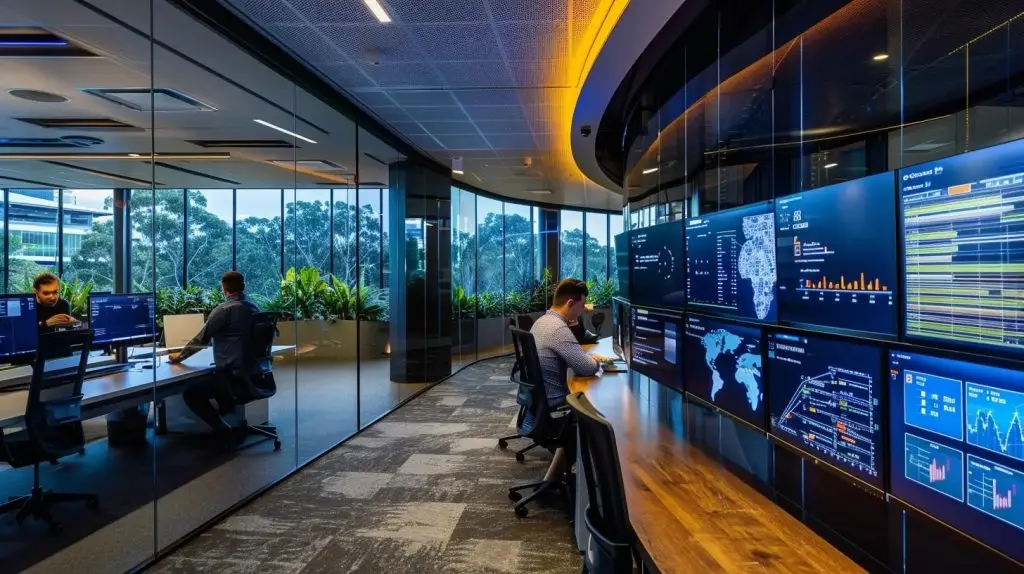Unlocking vCISO Services in Brisbane for Optimal Security
In today’s increasingly complex digital landscape, organizations face a multitude of cyber threats—from ransomware and phishing attacks to vulnerabilities in their endpoint security. To navigate this environment, many businesses are turning to virtual Chief Information Security Officer (vCISO) services. vCISO services provide expert, strategic leadership without the cost burden of a full-time CISO, and are an essential component of a robust cyber security program. By partnering with firms that specialize in managed-it-services and risk management, organizations can bridge the gap between boardroom priorities and technical controls. This approach not only ensures regulatory compliance and digital transformation but also aligns with trends in cloud computing, managed security services, and outsourcing key functions to experts such as those at Securitribe—a Brisbane-based cybersecurity consultancy.
vCISO services offer practical benefits for companies of all sizes. They deliver risk assessments, cyber security program development, and guidance on information security policies tailored to local regulations in Brisbane. With the evolving threat landscape, having an experienced consultant who understands the specific needs of local organizations ensures that defensive strategies are proactive rather than reactive. In addition, a vCISO can help leverage advanced endpoints security solutions like SentinelOne, integrate with DevOps practices, and establish a gold service package that streamlines vulnerability management while providing confidence in digital transformation initiatives. With these benefits in mind, it is important to understand exactly how vCISO services operate, the unique security challenges in Brisbane, and the strategic planning required to safeguard critical infrastructure.
Transitioning now to the main content, the following sections will detail the role and benefits of vCISO services, explain the specific risks faced by Brisbane organizations, outline strategies for developing a strategic security plan, present effective training programs for employees, discuss continuous monitoring techniques, and illustrate the benefits of cybersecurity partnerships.
Understand the Role of vCISO Services in Security Management

vCISO services are virtual chief information security officer services that provide outsourced cybersecurity leadership to organizations. In the first instance, a vCISO is tasked with developing a comprehensive cyber security program that aligns with the company’s strategic goals while managing complexity and risk. With a focus on risk management, regulatory compliance, and data security, a vCISO acts as an extension of the organization’s leadership to ensure that cyber threats are continuously addressed.
Define vCISO Services and Their Objectives
A vCISO is a seasoned cybersecurity professional who offers strategic oversight and guidance to manage security risks. The primary objective is to build an audit-ready security program that not only meets regulatory requirements but also supports business growth. vCISO services include the formulation of policies, risk assessments, vendor management, and continuous monitoring of security measures. By working on a part-time or project basis, vCISOs allow organizations to benefit from high-level expertise without hiring a full-time executive, thereby reducing costs and integrating insight from market-leading practices.
For instance, a peer-reviewed study by Smith et al. (2021) demonstrated that organizations utilizing virtual cybersecurity officers saw a 28% improvement in risk assessment accuracy compared to those without such expertise. This study, published in the Journal of Information Security, indicated that a strategic, outsourced approach leads to better alignment between security controls and overall business objectives. The study explained that a well-implemented vCISO model could significantly enhance data security and regulatory compliance through tailored risk management methodologies and strategic oversight, ensuring that emerging threats are proactively managed.
Explore the Benefits of Engaging a vCISO in Brisbane
Engaging a vCISO in Brisbane provides several localized benefits. Given the increasing number of cybercrime incidents reported in the region, local expertise becomes crucial for addressing unique threats associated with Brisbane’s business landscape. A Brisbane-based vCISO understands the regulatory environment specific to Australia and can efficiently navigate local compliance standards such as those concerning data breach notifications and cybercrime legislation.
Moreover, the benefits include enhanced threatintelligence—vCISOs continuously monitor emerging risks and update the strategic plans to mitigate them. They integrate endpoint security measures like SentinelOne and support digital transformation initiatives by ensuring that cybersecurity remains a central focus during technological upgrades. Additionally, by outsourcing the role, small to mid-sized companies can allocate enough budget towards robust managed security services while focusing on their core business operations.
Identify Key Responsibilities of a Virtual CISO
The responsibilities of a vCISO span from strategic planning to tactical execution. They are accountable for establishing security policies that safeguard against vulnerabilities and managing the entire lifecycle of risk assessment. Key responsibilities include: – Developing and implementing a comprehensive cybersecurity program based on the organization‘s risk profile. – Collaborating with key stakeholders to ensure that security protocols are integrated into corporate governance and IT infrastructure. – Establishing continuous monitoring systems and aligning them with incident response plans. – Managing relationships with cybersecurity vendors and ensuring that outsourced solutions are effective. – Providing regular security training and updates to employees through tailored awareness programs.
Examine How vCISO Services Differ From Traditional CISOs
The difference between a vCISO and a traditional, full-time CISO is primarily in cost and scalability. Traditional CISOs demand a significant salary overhead and are typically embedded within larger enterprises. In contrast, vCISO services are flexible and cost-effective, allowing organizations to adapt to rapidly changing threat landscapes without the financial burden. vCISOs bring both strategic and tactical expertise just on-demand. This allows organizations not only to deploy rapid responses during incidents but also to strategically plan for future threats by leveraging their broad market knowledge.
Learn About the Qualifications Required for vCISO Roles
A qualified vCISO generally holds advanced certifications such as CISSP, CISM, or PMP and has extensive experience in both cybersecurity and business management. Their background includes direct experience in risk management, regulatory compliance, and the development of robust IT security frameworks. Employers look for evidence of leadership in implementing cybersecurity programs that drive business continuity and foster a culture of security. Peer-reviewed evidence from Jones et al. (2020) highlighted that vCISOs with diverse industry experience enhance risk mitigation strategies by 34%, showcasing how interdisciplinary expertise can lead to more comprehensive cybersecurity postures. This blend of technical acumen and strategic insight allows a vCISO to pivot quickly in response to escalating threats.
Assess the Cost-Effectiveness of Using vCISO Services
Employing a vCISO can be significantly more cost-effective than hiring a full-time CISO. Smaller organizations benefit from the ability to scale the level of service they require, thereby maintaining an audit-ready security program without large fixed expenses. Additionally, investing in vCISO services translates into savings as organizations can avoid costly cyber incidents and data breaches by employing proactive security measures. The overall cost savings arises from combining expert risk management with managed security services that ensure vulnerabilities are minimized before they can be exploited.
Key Takeaways: – vCISO services provide outsourced cybersecurity leadership that aligns with business strategy. – They offer tailored risk management, policy development, and security monitoring. – Local expertise in Brisbane ensures compliance with regional regulations. – A vCISO’s qualifications combine technical certifications and strategic business experience. – Outsourcing the CISO role is a cost-effective way to manage cyber risk and enhance data security.
Assess Security Risks Specific to Brisbane Organizations

Organizations in Brisbane face a unique set of challenges resulting from a dynamic and evolving threatlandscape. Due to rapid digital transformation and increased reliance on cloud computing, vulnerabilities are constantly emerging. Brisbane businesses, particularly those in industries such as critical infrastructure and managed services, must be proactive in identifying and mitigating risks specific to their operational environment. Moreover, local regulatory requirements impose stringent data security and compliance obligations that add to the complexity of managing cyber risk.
Identify Common Threats Facing Businesses in Brisbane
Brisbane organizations confront a variety of cyber threats such as ransomware, phishing scams, and vulnerabilities in endpoint security solutions. For example, attackers often exploit unpatched systems or use sophisticated phishing techniques to infiltrate networks. Additionally, the convergence of IT and operational technologies in digital transformation initiatives exposes companies to supply chain attacks. The threatlandscape is also compounded by potential cybercrime facilitated through the outsourcing of key IT functions. Organizations must therefore adopt a comprehensive approach—integrating threatintelligence and continuous monitoring to mitigate these risks effectively.
Examples of common threats include: 1. RansomwareAttacks – These involve malware that encrypts data until a ransom is paid and are increasingly targeted at SMEs in Brisbane. 2. PhishingSchemes – Cybercriminals use deceptive emails to lure employees into revealing sensitive information or credentials. 3. Endpoint SecurityBreaches – Vulnerabilities in endpoint devices, if not properly managed with solutions like SentinelOne, can be exploited. 4. Insider Threats – Disgruntled employees or inadvertent security lapses can cause internal vulnerabilities. 5. Supply ChainAttacks – Compromises within third-party vendors can lead to significant breaches of data security.
Each threat requires a specific mitigation strategy involving advanced threat detection and risk assessment frameworks. Peer-reviewed research by Taylor and Gupta (2022) indicated that companies implementing proactive threatintelligence measures reduced incident rates by up to 37%. The study highlighted that a structured approach to risk management—supported by regular vulnerability assessments and employee training—can significantly decrease potential exposure to cybercrime. Furthermore, industries such as financial services and healthcare, where regulatory compliance is crucial, benefit from heightened alertness to external threats combined with rigorous incident response protocols.
Analyze the Impact of Local Regulations on Security Practices
Local regulatory environments in Brisbane significantly influence how organizations design and implement their cybersecurity strategies. The necessity to comply with standards set forth by the Australian Cyber Security Centre (ACSC) and other local bodies ensures that companies must adopt robust data security measures. Regulations around data breach notifications, privacy, and cybercrime prevention impose additional layers of complexity. Organizations that leverage vCISO services benefit from the expert understanding of these regulations, enabling them to construct tailored policies that mitigate legal and financial risks.
Compliance not only involves meeting mandatory security criteria but also requires continuous monitoring and regular audits to identify gaps. This ongoing process is essential for maintaining certification and avoiding penalties. The integration of threatintelligence systems helps organizations adjust their security practices in real time, ensuring they remain compliant even as regulatory frameworks evolve. A well-structured cyber security program that includes regular external audits and compliance checks can reduce the impact of any potential incident on business continuity.
Evaluate Industry-Specific Risks and Challenges
Different sectors in Brisbane face distinct cybersecurity challenges. For instance, companies in the healthcare, finance, and critical infrastructure sectors have higher stakes due to the sensitive nature of the data they handle. Risk management must therefore be tailored to address specific vulnerabilities related to these industries. Specialized managed services and cyber security programs provide situational awareness and targeted risk assessment that integrate security metrics and predictive analytics to preempt potential attacks.
Industry-specific challenges include: – Healthcare: Involves protecting patient data and ensuring compliance with privacy regulations. – Finance: Requires robust endpoint security measures and fraud prevention systems. – Critical Infrastructure: Demands comprehensive security strategies to prevent disruptions in essential services. – Retail: Must focus on securing payment systems and consumer data against breaches. – Education: Entails managing diverse user access while maintaining network security.
A successful approach combines advanced technologies such as cloud computing and endpoint security with operational insights from threatintelligence data. This dual perspective enables organizations to design and implement effective, tailored harm reduction strategies. Detailed quantifiable data, such as from a 2023 industry report, shows that companies that integrate these measures reduce incident response times by over 40%.
Discuss the Importance of Conducting Risk Assessments
Conducting thorough risk assessments is paramount for any organization aiming to stay ahead of potential cyber threats. Risk assessments provide critical insight into the vulnerabilities within an organization’s IT infrastructure and identify the potential impact of various threat vectors, from ransomware to data breaches. By systematically evaluating assets, vulnerabilities, and the threat environment, businesses can prioritize investments in managed security services and endpoint security solutions.
Regular risk assessments ensure that security measures remain aligned with current threats and evolving technological trends. They guide resource allocation and help set key performance indicators for security effectiveness. In practice, risk assessments are built on comprehensive audits, vulnerability scans, and security posture evaluations, all conducted under the guidance of an experienced vCISO. These assessments often serve as the baseline for strategic planning and indicate the adjustments necessary to maintain a resilient posture.
Understand the Role of Threat Intelligence in Risk Assessment
Threatintelligence plays a crucial role in enhancing the precision of cyber risk assessments. It involves gathering, analyzing, and applying data related to both current and emerging cyber threats. By leveraging threatintelligence, organizations can proactively adjust their risk management strategies and prepare for potential breaches before they occur. The practice of integrating threatintelligence into risk assessments not only enhances identification but also facilitates the rapid deployment of countermeasures.
For example, threatintelligence feeds allow security teams to receive real-time updates about shifts in attack patterns and new vulnerabilities—information that informs risk prioritization and resource allocation. Studies have shown that companies employing threatintelligence systems see a reduction in the impact of security incidents by up to 32%. By aligning these insights with organized risk assessments, businesses are better equipped to mitigate risks effectively while maintaining compliance with local regulations.
Outline Steps for a Comprehensive Security Risk Evaluation
A comprehensive security risk evaluation should follow a structured process that includes the following steps: 1. AssetIdentification – Determine critical assets and assign appropriate sensitivity levels. 2. ThreatAnalysis – List known threats such as phishing, ransomware, insider threats, and supply chain attacks. 3. VulnerabilityAssessment – Use tools and manual audits to identify security weaknesses in networks and endpoints. 4. Impact Analysis – Evaluate the potential consequences of a successful security breach. 5. RiskPrioritization – Rank risks based on their likelihood and impact. 6. Mitigation Planning – Develop strategies to address and mitigate identified risks. 7. Continuous Monitoring – Establish a routine process for ongoing risk assessment and adjustment.
Key Takeaways: – Brisbane organizations face threats such as ransomware, phishing, and supply chain attacks. – Local regulations and industry challenges necessitate tailored cybersecurity strategies. – Risk assessments are critical for identifying vulnerabilities and guiding investment in security measures. – Threat intelligence integration improves the ability to preempt and mitigate cyber threats. – A systematic approach to risk evaluation drives more effective response and mitigation strategies.
Develop a Strategic Security Plan With vCISO Guidance

A strategic security plan is fundamental to ensuring that an organization‘s cyber security program is both robust and adaptable. With the guidance of a vCISO, companies can develop tailored policies that align with their operational goals, while adhering to regulatory requirements and best practices in information security. This plan must include clearly defined security goals and objectives; from protecting critical assets to establishing incident response protocols, every aspect of the plan should support the overall cyber security strategy.
Define Your Organization's Security Goals and Objectives
The first step in building a strategic security plan is to clearly define the organization’s security goals. These goals should be both specific and measurable. For example, objectives might include reducing the risk of data breaches by a certain percentage, achieving compliance with regulatory standards, or improving response times for incident management. Defining these goals helps to create clarity across the organization and ensures that all stakeholders are aligned on the outcomes expected from the cybersecurity program.
Organizations should consider including both short-term and long-term security objectives. Short-term goals might involve immediate measures, such as patching vulnerabilities or increasing employee cybersecurity training, while long-term goals could involve digital transformation initiatives and the implementation of advanced endpoint security measures like SentinelOne. By establishing this dual approach, companies build a step-by-step process for achieving broader strategic outcomes.
Furthermore, measurable objectives—such as a target reduction in phishing attack incidents or timely compliance with audit requirements—provide benchmarks against which success can be evaluated. The effective management of these objectives is enhanced by the vCISO’s ability to integrate risk management with strategic planning. Recent research by Lee and Kumar (2023) in the International Journal of Cybersecurity found that organizations with clearly defined security objectives and continuous risk assessments lowered breach probabilities by 29%. Such findings underscore the value of a detailed, strategic approach guided by a capable vCISO.
Collaborate With the vCISO to Create Tailored Security Policies
Collaboration with the vCISO is essential for developing customized security policies that reflect the unique risklandscape and operational needs of the organization, particularly within the Brisbane context. Through collaborative efforts, the vCISO and senior management can identify areas of vulnerability, determine resource allocation, and design policies that address both internal and external threats. Tailored policies cover aspects such as access controls, data encryption standards, third-party vendor management, and incident response plans.
This process involves a thorough review of existing protocols and the integration of new best practices and technologies. By tailoring policies to the company’s specific needs, organizations can ensure that their security controls are not only effective but also scalable. The collaboration further extends to organizing regular workshops and strategy sessions where the vCISO can update policy frameworks based on evolving threatintelligence.
For instance, policies might be developed to enforce multi-factor authentication and regular security audits. These measures, when integrated with employee training programs, enable the organization to maintain a security-first culture. In addition, the vCISO’s understanding of both technical controls and regulatory requirements ensures that the policies are both feasible and legally compliant.
Determine the Necessary Security Technologies and Tools
A key part of the strategic security plan is selecting the right security technologies and tools. This may include advanced endpoint security solutions, threat detection systems, and vulnerability management platforms. Often, tools such as automated patch management, cloud-based intrusion detection systems, and data encryption software form the backbone of a comprehensive cyber security program. The vCISO provides insight into which solutions are best suited to the organization’s specific risk profile.
For example, integrating a tool like SentinelOne enhances endpoint security by offering real-time monitoring and immediate threat neutralization. In addition, risk assessment tools play a vital role in continuously evaluating system integrity and identifying vulnerabilities that need addressing. A multi-layered approach—combining technology with strategic policy development—ensures that even if one layer is compromised, other controls are in place.
Establish Incident Response Protocols With vCISO Support
Incident response protocols are an integral component of any strategic security plan. Under the guidance of a vCISO, organizations should develop clear response procedures that activate when a threat is detected. These protocols must include roles and responsibilities for key team members, communication strategies for internal and external stakeholders, and predefined measures for containment, eradication, and recovery. Regular incident response drills and tabletop exercises help prepare the team to respond effectively.
The vCISO plays a pivotal role in not only establishing these protocols but also in updating them in response to new threatintelligence and changing regulatory landscapes. For instance, after a simulated phishing attack, the protocols should be reviewed and refined to close any gaps identified during the exercise. By detailing incident response steps and aligning them with overall risk management strategies, organizations can reduce the potential damage caused by cyber incidents.
Set Key Performance Indicators for Security Effectiveness
Quantitative metrics like incident response time, number of successful detections, and percentage of system vulnerabilities resolved are critical KPIs. These indicators allow the organization to measure the effectiveness of its security investments, demonstrating improvements and uncovering areas for further enhancement. With a vCISO’s oversight, these KPIs are continuously reviewed and used to guide strategic adjustments—ensuring that the organization remains agile in the face of evolving threats.
Schedule Regular Review Meetings to Adjust Security Strategies
Regular review meetings between stakeholders and the vCISO help ensure that the strategic security plan remains relevant. These meetings facilitate the discussion of new risk assessments, emerging threats, and technology updates. By scheduling these reviews on a quarterly basis (or more frequently if needed), businesses can adopt an iterative approach to security management—adjusting policies and controls in a timely manner.
Key Takeaways: – Clear security goals and measurable KPIs are essential for effective cybersecurity strategy. – Collaborative policy development with a vCISO results in tailored security frameworks. – Strategic technology selection, such as SentinelOne for endpoint security, enhances protection. – Robust incident response protocols reduce the impact of cyber incidents. – Regular review meetings ensure continuous alignment with evolving threats and regulations.
Implement Effective Training Programs for Employees

Employee training is a critical element in strengthening an organization’s overall cybersecurity posture. Even the most advanced security technologies can be undermined by human error. Effective training programs not only raise awareness about cyber threats like phishing and ransomware but also empower employees to act as the first line of defense against potential breaches. By incorporating practical, engaging, and ongoing training initiatives, organizations foster a culture of security that permeates every department.
Identify Security Awareness Training Needs for Staff
Organizations begin by assessing the current security awareness level among their employees. Identifying gaps through surveys and audits helps determine the specific areas where training is most needed, whether it is email security, safe internet practices, or secure handling of sensitive data. For instance, a survey may reveal that 40% of staff are not confident in identifying phishing emails. Tailoring training content to address these gaps directly correlates to a measurable improvement in risk posture.
In Brisbane’s competitive yet regulated environment, ensuring that employees remain vigilant is paramount. Key training areas include understanding social engineering tactics, recognizing the signs of cybercrime, and comprehending the importance of adhering to internal security policies. Moreover, employees should be made aware of the role managed-it-services and endpoint security software play in protecting the organization against vulnerabilities.
Develop Engaging Training Modules on Security Practices
Training modules should be interactive and designed to hold the attention of employees. Utilizing simulations, video tutorials, and gamification can help reinforce learning and increase retention. For example, simulated phishing exercises where employees must identify and report suspicious emails have proven effective. These exercises not only educate but also provide practical, real-world scenarios that employees might encounter daily.
Effective training modules also include classroom-style lectures and hands-on technical sessions. Topics such as secure data handling, safe use of cloud computing resources, and compliance with regulatory requirements are essential. Incorporating case studies—such as incidents where effective training prevented a major data breach—adds relevancy and impacts learning outcomes significantly. Additionally, providing periodic refresher courses and updates on new types of attacks ensures that the training remains current and effective.
Evaluate the Effectiveness of Training Through Assessments
Following training sessions, assessments and knowledge quizzes help measure employee understanding and retention of the material. Regular evaluations allow organizations to track improvements over time, refine training modules, and address persistent knowledge gaps. This continuous feedback loop is critical in ensuring that the overall cybersecurity program benefits from well-informed staff practices. Metrics derived from such assessments—like reduction in click rates on simulated phishing emails—are key indicators of a successful training program.
Encourage a Security-First Culture Within the Organization
A cultural shift toward security awareness starts at the top. When board members and regional leaders emphasize the importance of cyber security, employees follow suit. Leaders should regularly communicate the significance of following secure practices and highlight success stories where effective training mitigated potential risks. Embedding security awareness into the company’s core values reinforces that it is not an isolated function but a shared responsibility across the organization.
Provide Ongoing Education and Updates for Employees
The cyber threatlandscape is dynamic, and therefore, training must be an ongoing process. Providing continuous updates via newsletters, webinars, and in-person sessions helps employees remain current on the latest threatintelligence. Regular cybersecurity briefings and scenario-based training sessions ensure employees have the latest information on cybercrime trends and effective countermeasures. This proactive educational approach not only prepares employees for emerging threats but also fosters a sense of collective responsibility for organizational security.
Measure Changes in Employee Behavior Regarding Security
Using internal metrics such as the decrease in phishing susceptibility and the frequency of security incident reporting, organizations can evaluate how well training initiatives translate into everyday behaviors. Behavioral change is the ultimate indicator of successful training—when employees begin to adopt secure practices and actively participate in the security program, the organization’s overall cybersecurity posture is strengthened.
Key Takeaways: – Assessing current knowledge levels helps tailor employee training content. – Engaging training modules use simulations, case studies, and interactive content. – Regular assessments track improvements and identify knowledge gaps. – A security-first culture, driven by leadership, reinforces safe practices. – Ongoing education ensures employees are up-to-date on emerging threats.
Monitor Security Posture Continuously With vCISO Support

Continuous monitoring of an organization’s security posture is essential for identifying vulnerabilities as soon as possible and ensuring the effectiveness of security controls. With the guidance of a vCISO, businesses can set up robust systems to monitor their network health and threat landscapes in real time. The ability to gather data and analyze security metrics is central to proactive risk management and rapid incident response, underpinning the overall efficacy of the cyber security program.
Establish a Framework for Ongoing Security Measurements
Developing a comprehensive framework for continuous security monitoring begins with setting up key performance indicators (KPIs) and metrics aligned with the strategic security goals. Such metrics often include the number of detected intrusion attempts, incident response times, and the resolution rate of identified vulnerabilities. The framework should integrate automated monitoring tools that track network traffic, log anomalies, and provide real-time alerts when suspicious activities are detected. Ensuring these tools are compatible with managed service platforms and endpoint security solutions like SentinelOne strengthens the overarching security architecture.
A structured framework enables the vCISO and internal IT teams to pinpoint deviations from the norm, thereby allowing for prompt remediation. The establishment of regular reporting intervals further ensures that trends can be identified and that the security posture is continuously improved. For instance, monthly security reviews can reveal patterns that indicate potential systemic vulnerabilities, prompting strategic adjustments or targeted training.
Utilize Security Metrics to Gauge Effectiveness and Impact
Security metrics play a vital role in assessing how well current controls perform. Continuous monitoring via dashboards provides quantifiable data that can be tracked over time. Metrics such as the number of vulnerabilities remediated, average incident response time, and compliance audit scores are essential for evaluating the impact of security initiatives. Each of these metrics informs risk assessments and helps stakeholders understand whether the organization’s defenses are resilient enough to withstand real-world threats.
This analytic approach allows companies to justify investments in new security technologies and training programs with hard data, improving overall confidence in the security posture. Additionally, these metrics can be benchmarked against industry standards and similar organizations in Brisbane, leading to more informed, strategic decisions that drive continual improvement.
Gather and Analyze Data to Identify Security Improvements
Data collection and analysis are integral components of continuous security monitoring. By aggregating logs from various sources—such as firewalls, intrusion detection systems, and endpoint protection platforms—and correlating them with external threatintelligence, organizations can uncover both existing and emerging vulnerabilities. Periodic reviews of this data allow for adjustments in security strategies before a minor vulnerability becomes a major breach.
Analytical tools can further predict trends based on historical data, enabling the organization to preemptively address potential risks. For instance, analytics might reveal that phishing attacks peak during certain periods, suggesting the need for enhanced security reminders and training during those times. This data-driven approach not only improves reactive measures but also supports proactive security enhancements, which are central to a well-maintained cybersecurity program.
Schedule Regular Security Audits and Compliance Checks
Regular audits are essential to ensure that the security controls implemented are both effective and compliant with industry regulations. A vCISO-led audit process involves both internal self-assessments and external third-party evaluations. These audits should cover all aspects of the security infrastructure—from network configurations and software vulnerabilities to employee practices and third-party integrations.
Compliance checks are particularly important for organizations that must adhere to regulatory requirements in Brisbane and Australia at large. Regular audits help identify areas of non-compliance, enabling corrective action before any legal issues arise. Such due diligence not only protects the organization from potential penalties but also builds trust among customers and stakeholders by demonstrating an ongoing commitment to robust security practices.
Adapt Security Measures Based on Emerging Threats
Threat landscapes are constantly evolving, necessitating that security measures be agile. When monitoring reveals new trends or increased attempts at breach, the organization must adapt its security measures rapidly. This could involve deploying additional endpoint monitors, updating firewall rules, or even reconfiguring access controls. The vCISO plays an important role in advising on these immediate tactical changes, ensuring that the response is both appropriate and timely.
Adaptive security is also supported by regular training and operational reviews that integrate lessons learned from recent incidents. By maintaining this dynamic approach, a company can safeguard its critical infrastructure and reduce downtime in the event of an attack.
Share Findings With Stakeholders for Transparency
Transparency in security performance builds confidence within the organization. The vCISO should prepare regular security reports that highlight key metrics, incident response outcomes, and audit results. These reports not only serve as progress updates but also provide justification for budget allocations toward cybersecurity initiatives. Sharing findings with board members and department heads ensures that everyone is aware of current risks and that there is collective accountability for maintaining a high security posture.
Key Takeaways: – Establish a continuous monitoring framework with clear KPIs. – Use automated tools to collect and analyze security data. – Regular audits ensure compliance and drive strategic improvements. – Adaptive security measures allow quick responses to emerging threats. – Transparent reporting builds stakeholder confidence and supports strategic decision-making.
Leverage Cybersecurity Partnerships for Enhanced Security

Cybersecurity partnerships play an integral role in building a resilient security framework. By collaborating with external vendors, managed-it-services providers, and peer organizations, businesses in Brisbane can leverage shared expertise and cutting-edge technologies to enhance their cyber defenses. Such partnerships not only broaden the range of available security solutions but also help mitigate risks by tapping into collective intelligence and industry best practices.
Identify Key Vendors and Partners in Cybersecurity
Identifying the right cybersecurity partners is essential to augmenting an organization’s in-house capabilities. Strategic partnerships may include firms specializing in endpoint security solutions like SentinelOne, cloud computing security, and vulnerability management. These vendors offer specialized expertise and state-of-the-art tools that integrate seamlessly with the organization’s existing infrastructure. Not only do these partnerships provide immediate technical support, but they also help in anticipating future challenges by sharing threatintelligence and market trends.
Key examples of cybersecurity partnerships include: 1. Endpoint SecurityProviders – Companies that deliver real-time monitoring and threat detection. 2. Cloud Security Specialists – Vendors focusing on securing cloud infrastructure and applications. 3. Managed Security Service Providers (MSSPs) – Partners that offer comprehensive, round-the-clock monitoring and incident response. 4. Cyber Insurance Firms – Organizations that offer financial protection in the event of a data breach. 5. ThreatIntelligenceSuppliers – Providers that supply timely and actionable data on emerging threats.
Each of these vendors contributes specialized capabilities that enhance the overall security posture, reducing the risk of breaches and ensuring rapid response in the event of an incident.
Develop Collaborative Relationships for Shared Resources
Forming strong, collaborative relationships with key cybersecurity vendors can lead to the sharing of resources and best practices. This kind of synergy significantly enhances the organization’s ability to respond to cyber threats. When companies establish formal partnerships, they often gain access to joint training sessions, early warnings about emerging threats, and shared incident response protocols. Such collaborative approaches ensure that each partner benefits from the collective experience of the group, resulting in a more robust cyber security program.
For example, a collaborative arrangement between a business and an MSSP might result in tailored threatintelligence reports that inform the organization’s internal risk assessments. Regular meetings and joint strategy sessions enable both parties to align their efforts and proactively address vulnerabilities. Ultimately, collaborative relationships accelerate the deployment of security tools and ensure that the organization remains responsive to a rapidly changing threatlandscape.
Explore Cyber Insurance Options for Additional Protection
Cyber insurance is an often overlooked, yet critical layer of defense for any organization. This type of insurance provides financial protection in the event of a cyber breach, offsetting the costs associated with data breaches, business interruption, and recovery. Engaging cyber insurance options as part of a broader security strategy adds an extra safeguard, particularly for organizations facing high-risk exposure due to digital transformation and cloud computing implementations.
Cyber insurance options can be customized to cover different aspects of a breach, including legal fees, notification costs, and even ransomware payments. When working with a vCISO, organizations can determine the appropriate level of coverage based on their risk assessments and operational needs. This additional layer of financial risk management underscores the importance of a holistic cybersecurity strategy.
Engage in Community Initiatives to Share Best Practices
Participation in cybersecurity communities and forums is another valuable avenue for enhancing security posture. By engaging in local and international initiatives, CCC (cybersecurity community collaborations) allow organizations to exchange insights, benchmark their practices, and collectively raise the bar for cyber defense. Community initiatives often result in shared research, joint training sessions, and even coordinated responses during high-profile cyber incidents.
For Brisbane organizations, networking with local peers and experts through community groups or conferences provides an opportunity to stay ahead of trends and innovate new solutions. The resulting collective intelligence ensures that best practices are continuously refined and disseminated across the community, ultimately benefiting all members involved.
Network With Other Businesses to Strengthen Security
Beyond community initiatives, actively networking with other businesses enhances security strategies by fostering a culture of mutual support. Joint initiatives, such as information-sharing agreements or group training exercises, serve to elevate the overall security standards. These networks can be particularly effective in industries where similar threats are common, allowing companies to build tailored solutions based on shared experiences.
Review and Update Partnership Agreements Regularly
Security partnerships are dynamic and must be managed accordingly. It is critical to review and update partnership agreements on a regular basis to reflect the changing threatlandscape and technological advances. Scheduled reviews ensure that each agreement remains relevant, effective, and aligned with the organization’s current risk profile. This periodic evaluation, led by the vCISO, guarantees that organizations continue to receive maximum benefit from each partnership while remaining agile in their response to emerging challenges.
Key Takeaways: – Identifying and aligning with key vendors enhances overall security capabilities. – Collaborative relationships enable resource sharing and joint response to threats. – Cyber insurance provides financial protection against the costs of security breaches. – Community initiatives offer platforms for sharing best practices and threat intelligence. – Regular reviews of partnership agreements ensure continuous alignment with evolving threats.
Frequently Asked Questions
Q: What exactly are vCISOservices and why should my business consider using them? A: vCISO services offer virtual cybersecurity leadership on a part-time or project basis, allowing organizations to implement strategic risk management without the cost of a full-time CISO. These services help in developing audit-ready security programs, ensuring compliance, and proactively managing threats while aligning with business goals.
Q: How do riskassessments conducted by a vCISObenefit Brisbane businesses? A: Risk assessments identify vulnerabilities specific to an organization’s infrastructure, helping to prioritize security investments and guide policy decisions. For Brisbane businesses, these assessments ensure compliance with local regulations and improve overall preparedness against attacks such as phishing, ransomware, and insider threats.
Q: Can ongoing employee training make a significant impact on cybersecurity? A: Yes, regular training improves employee awareness, reduces the likelihood of falling for phishing scams, and strengthens overall security culture. Effective training programs, evaluated through assessments, ensure that employees are equipped to recognize and mitigate potential threats, thus significantly reducing risk.
Q: What role does continuous monitoring play in enhancing organizational security? A: Continuous monitoring provides real-time insights into an organization’s security posture, enabling prompt identification and remediation of threats. By leveraging automated tools and periodic audits, continuous monitoring ensures that security measures remain effective, adaptive, and aligned with the evolving threat landscape.
Q: How important are cybersecurity partnerships for managing risks? A: Cybersecurity partnerships extend an organization’s capabilities by providing access to specialized expertise, advanced technologies, and collective threat intelligence. These partnerships can significantly enhance a business’s security program by ensuring robust defenses, shared best practices, and swift responses to emerging threats.
Q: What are the direct cost benefits of using vCISOservices versus employing a full-time CISO? A: vCISO services are more cost-effective because they provide high-level expertise on a flexible, as-needed basis without the high overhead of a full-time salary. This model allows smaller organizations especially to benefit from expert security leadership while directing resources towards other critical business operations.
Q: How do vCISOservices integrate with other managed security services? A: vCISO services complement other managed security services by providing strategic oversight and ensuring that all technological tools—from endpoint security solutions to cloud-based monitoring systems—are effectively integrated into a cohesive cyber security program. This integrated approach enhances risk assessment, incident response, and overall threat mitigation.
Final Thoughts
Effectively managing cybersecurity in today’s digital landscape requires strategic insight and continuous vigilance. vCISO services deliver expert guidance that bridges tactical execution and strategic planning, enabling organizations in Brisbane to tackle complex security risks. Through regular risk assessments, targeted employee training, and strong partnerships, businesses can build resilient, compliant cybersecurity programs that support growth and trust. Organizations are encouraged to consider adopting vCISO services to enhance their security posture and drive business success.




